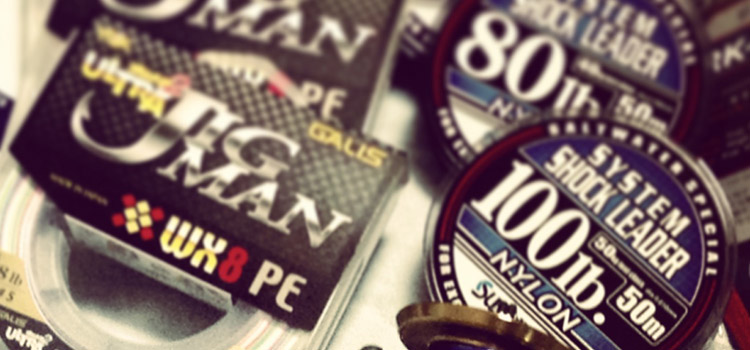When you check Japanese rods, reels and lines you may see Japanese size “Gou” – written as ”号” in Japanese – and wonder, what is it? How strong is it in Pond Test?
As I am one of the Japanese angler in overseas I often encountered to the same issue.
Here I introduce you some information about Japanese size “Gou” and Pond Test strength for “Gou”.
Traditional Japanese Line Size “Gou (号)”
This is the most used line size for long while. This entity is mainly used to show how thick the line is, and it is actually based on the line’s weight originally.
in 1947 one of the biggest fishing line maker TORAY made the first mono line “Ginrou” in Japan, and they established to as 1 Gou = 0.165mm (diameter of a mono line), and it is used on most of line maker in Japan now a days.
However this guide was only to mono-nylon line, so actually, even though some fluorocarbon and braids line have Gou, those can have similar, but different diameter than mono lines. And that’s why often when you see the line capacity of Japanese reels capacity of the same Gou of mono, fluoro and braids are different.
But finally in 2010, JAFTMA – Japan Fishing Tackle Manufacturers Association has established the common guideline for mono, fluoro and braids.
“Gou (号)” and line diameter
Here is the list of how thick Gou (shown as #) are below:
| Gou (#) | Diameter (mm) | Mono line strength (lb) | Braided line strength (lb) |
|---|---|---|---|
| 0.1 | 0.053 | 0.4 | 4 |
| 0.2 | 0.074 | 0.8 | 5 |
| 0.3 | 0.090 | 1.2 | 6 |
| 0.4 | 0.104 | 1.6 | 8 |
| 0.5 | 0.117 | 2 | 10 |
| 0.6 | 0.128 | 2.4 | 12 |
| 0.8 | 0.148 | 3 | 16 |
| 1 | 0.165 | 4 | 20 |
| 1.2 | 0.185 | 4.8 | 24 |
| 1.5 | 0.205 | 6 | 30 |
| 2 | 0.235 | 8 | 40 |
| 2.5 | 0.260 | 10 | 50 |
| 3 | 0.285 | 12 | 55 |
| 4 | 0.330 | 16 | 60 |
| 5 | 0.370 | 20 | 80 |
| 6 | 0.405 | 22 | 90 |
| 8 | 0.470 | 28 | 100 |
| 10 | 0.520 | 35 | 130 |
* Strength is basic and average, which can be different on each brands / models.
Calculation of Gou and Pond Test
In English countries, as you know, the line are shown as pond test, lb. However, because it just says the strength of the line not weight or diameter of the lines, you may have already experienced such situations – in my experience, I bought a reel saying “10lb mono line capacity: 200m” and bought a 10lb mono line, but I could only wrap 150m of the line to the reel. Of course I bought 200m line, the rest of 50m line were left and did not have any way to use them.
So, Gou the entity of diameters can be simple and useful to know line capacity. But in this case, you cannot expect the same Goued line has the same strength, as the quality and manufacturing can be differed by brands.
Usually, Gou can be transferred to lb by 4 times, meaning if a line is 2 Gou it can have 2 x 4 = 8lb pond test strength. Fluoro lines are actually a bit weaker than Mono-Nylon lines, so the actual pond test value is a bit lower than that, but not much.
And braids are told that it can be calculated by 10 times than the Gou number, meaning if a braid line is 2 Gou it can be 2 x 10 = 20lb pond test strength. Therefore when I purchase lines in Australia and wrap them to Japanese reels, I usually calculate the line capacities based on these.
So, if you want to attach Japanese line to your reels bought from local stores, I can expect totally opposite calculation, like if your reel has 10lb = 200m braid line capacities, I would buy 1 Gou 200m braid line from Japan. (Sorry to say, but cannot guaranteed.)
Actual Pond Test Value for Gou
But actual pond test value of the same Gou value can be different by brand, of course. It can also be differed by lines even in the same brand. And as technology is advanced day by day, especially the braid lines are much stronger than that now. Like, YGK Yoz-ami sells 2 type of game fishing line named “Galis Ultra Jigman” and “G-Soul X8 Upgrade”, and those are both 8 lines braided. But Ultra Jigman’s strength is this, 1 Gou = 18lb, and G-Soul ‘s 1 Gou = 22lb. Of course, they both have the same diameter.
In fishing, it is told that the narrower line is better, because you can cast further, the jig or sinker can be sunk faster, and the bite sign can be more obvious than thicker lines. So when I select lines, I often check the Gou and lb value, and tend to select the stronger line in the same Gou value, especially for small game fishing such as Bass, Eging etc.
At last, here are some lines recommended from me and people around me.
<PE (Braid) Line>
Small Game:
Game Fishing / Jigging


please can you help me to know how to convert gou to gram I’ve an old Japanese rod and i don’t know its cast weight the specs only 25 号 and the length
what means 25 号 please
Hi Tarek, that really depends on what type your fishing rod is, if it is kind of jigging / lure rods 25号 may mean line capacity then I suppose that could mean of 25号 mono line, which has 75 – 85lb, an diameter is about 0.825mm. If it is a fresh bait fishing rod, such as Iso rod (rock fresh bait fishing rod) / Cast rod (not lure / jig, but fresh bait fishing), seawall fishing rod or offshore fresh bait fishing rod, then it could mean 25号 sinker, which means you can use 93.75g sinker with that, and I assume this is what it means on your rod.
Hope this helps 🙂
If rod mentioned 30-60 号, what is that mean ?
Where can I get this equavalent chart for this japanese rod , mostly I just found the chart for line nylon and braided only.
Hi Din, thank you very much for your comment and am so sorry for late reply.
If your rod says 30-60 Gou it is sinker capacity, and 30 gou is around 112.5g (4oz) and 60 gou is around 225g (8oz).
i finnaly found the answer for my mistery, i have a rod from my dad and its marked 30号 its a 330 size rod for beach/rocks. Now i understaind, it stands for sink weight capacity, really thank you!!!
Hi Leonardo, that’s great you’ve got the answer 🙂
Hello. I have PEmax3G on my rod. What does it mean, how thick of a braid I can go with? Thank you
I have 0.6 gauge braid from varivus on my light bfs rod is it equal to 2.5 mono?
Hi Omer, thanks for your comment.
If it means you have PE#0.6 Gou braid line, then yes it is, mono 2.5lb is basically the same / similar diameter of #0.6 Gou.
But “Gou” or PE# number are basically the Japanese fishing line standards, so if your mono line is non-Japanese companies the diameter can be different.
Thank you for clarification
i just purchase a daiwa reel and on the spool, it states the line capacity as follows:
NYLON: 3lb (0.14mm) – 150m
4lb (0.16mm) – 100m
BRAID: #0.4 (0.05mm) – 200m
The diameter for nylon are almost same as the chart above but why is it for braid, it is 0.05mm instead of say 0.10mm?
Hi Chang,
I don’t know why exactly, though the line sizes are defined by Japan Fishing Tackle Manufacturers Association and normally all the fishing brands in Japan follows the guideline as in our article.
0.05mm is nearly equal to #0.1 gou but when you purchase braided line #0.4 that would not be thin like that.
If your country has local DAIWA service department I would suggest to ask them why and whether the values are right or not.
Hello,
Just purchase a Daiwa Rod which mentions that the casting wheight to be 3#g. Would you please advise what is in grams.
Best regards
Hi Filipe, thank you very much for your comment.
It really depends on what type of rods you have, but if yours is ISO rock rod then that #3 (Gou) points to what leader you can use, so #3 means #3 mono / fluoro – about 12lb, or around. like 10lb – 16lb.
And yes, It is the Expride 1610 M 1/4-3/4 oz rod I am talking about.
What the PE max 3G mark means on the rod? How thick of a braid in mm I can go with Thank you
Hi Dzmitry, thank you very much for your comment.
Expride 1610M has 2 line capacity for mono and braid, and MAX PE3 means max #3 braid lines, 0.296mm.
I have a 30-240 interline rod and I want to know how many grams of sinker? Ty
Hi, the sinker size of 30 Gou is about 112.5g 🙂